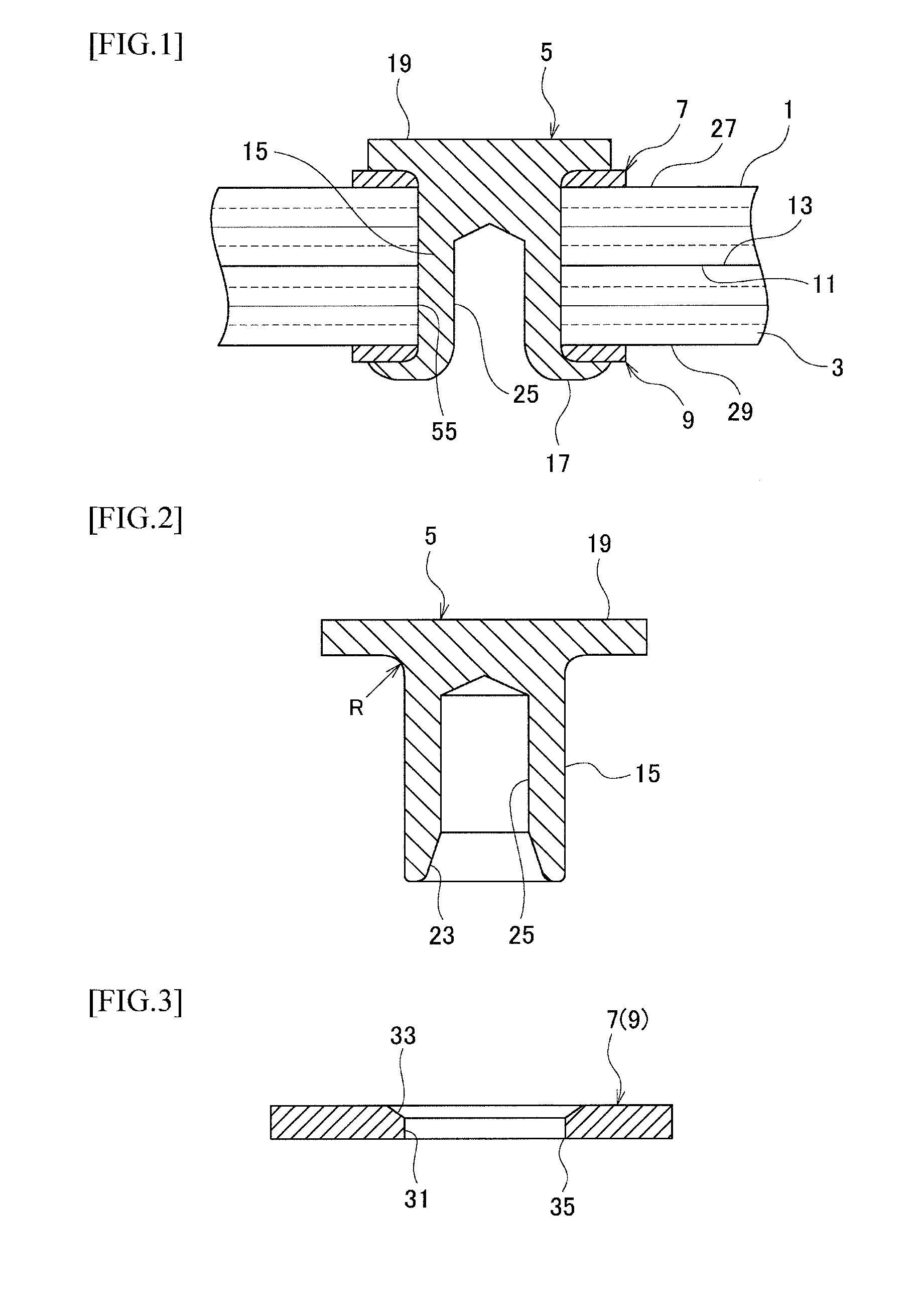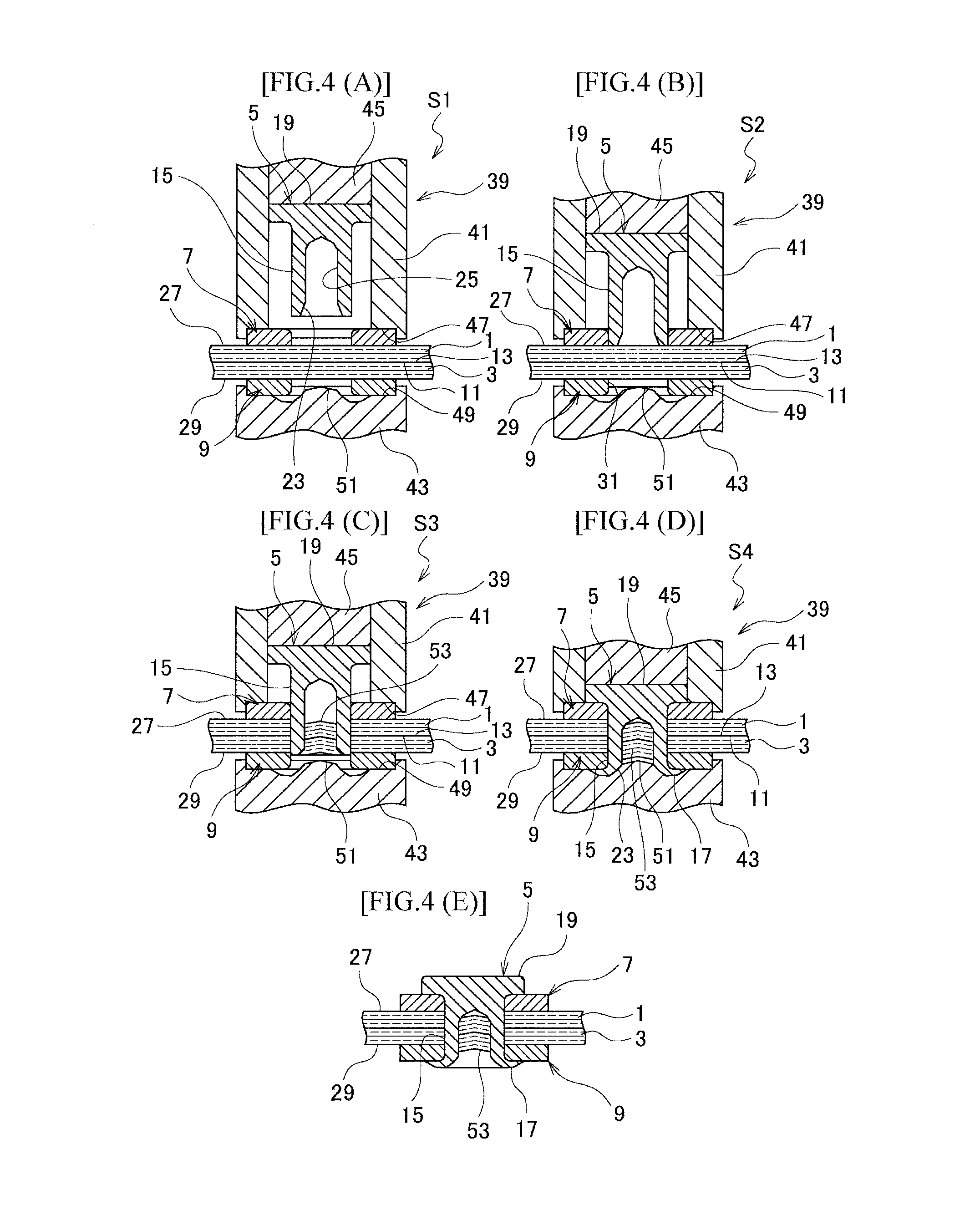Substrate joining method using rivet, and joining structure
a technology of rivets and joining structures, applied in the direction of threaded fasteners, screws, mechanical devices, etc., can solve the problems of reducing weight, requiring a long time for adhesive hardening, and no method of joining in a short time, so as to prevent the progress of separation or cracks, suppress stress concentration, and suppress the effect of cracks
- Summary
- Abstract
- Description
- Claims
- Application Information
AI Technical Summary
Benefits of technology
Problems solved by technology
Method used
Image
Examples
embodiment 1
[0039]FIG. 1 is a sectional view of a joining structure of plate materials. In addition, top and bottom, and left and right are hereinafter assumed as top and bottom, and left and right at the time of punching and joining processes by means of a self-piercing rivet (SPR).
[0040]The joining structure of the plate materials uses laminated plate materials 1 and 3 made of, for example, carbon fiber reinforced plastic (CFRP) as plate materials that are fastened and joined together by a SPR 5 through washers 7 and 9 as top and bottom seat members.
[0041]The laminated plate materials 1 and 3 are laid one on another with joining surfaces 11 and 13 being in contact with each other, and the washers 7 and 9 are arranged in contact with respective opposite surfaces 27 and 29 relative to the joining surfaces of the plate materials 1 and 3. The washers 7 and 9 each are a doughnut-shaped flat plate having an inner hole 31.
[0042]The SPR 5 as the rivet has a rivet, head portion 19 and a rivet shaft po...
embodiment 2
[0118]FIG. 12 shows sectional views illustrating a joining process in which (A) is a waiting step, (B) a punching start step, (C) a punching step, (D) a crimp waiting step, (E) a crimping step, and (F) a state after joining.
[0119]In a joining method and joining structure of plate materials using a rivet according to this embodiment 2, a rivet shaft portion 15E of a SPR 5D is solid and crimping of the rivet shaft portion 15E is press-crimping or spin-crimping. At an outer periphery of a front edge of the rivet shaft portion 15E is C-chamfered. The C-chamfering may be omitted.
[0120]The joining process of FIG. 12 uses a joining apparatus 67. In the joining apparatus 67, a lower punch 69 is changed with respect to the joining apparatus 39 of FIG. 4 and a press punch (or rotary punch) 71 for crimping is used as a replacement for the lower punch 69.
[0121]The punch 69 is a hollow shape, has a washer support recessed portion 49 formed on a top surface thereof, and has an outlet hole 71 for ...
embodiment 3
[0130]FIGS. 13 and 14 are sectional views illustrating a joining structure of plate materials according to the embodiment 3. The basic structure is the same as that, of the embodiment 1, and therefore, the same parts are represented with the same reference numerals and corresponding parts are represented with the same reference numerals with “F” to omit a duplicative explanation.
[0131]The joining structure of FIG. 13 uses, for example, a metal plate 3F and a laminated plate material 3 made of carbon fiber reinforced plastic (CFRP) as plate materials joined and fastened together using a SPR 5F through a washer 9 as a bottom seat member. As the metal plate 1F, a steel panel, stainless steel panel, duralumin panel, aluminum alloy panel may be used, but the material is not limited thereto. In addition, a washer as a top seat member on the metal plate 1F side may be concurrently used.
[0132]The joining structure of FIG. 14 uses, for example, a laminated plate material 1 made of carbon fib...
PUM
| Property | Measurement | Unit |
|---|---|---|
| stress concentration | aaaaa | aaaaa |
| stress concentration | aaaaa | aaaaa |
| thickness | aaaaa | aaaaa |
Abstract
Description
Claims
Application Information
 Login to View More
Login to View More - R&D
- Intellectual Property
- Life Sciences
- Materials
- Tech Scout
- Unparalleled Data Quality
- Higher Quality Content
- 60% Fewer Hallucinations
Browse by: Latest US Patents, China's latest patents, Technical Efficacy Thesaurus, Application Domain, Technology Topic, Popular Technical Reports.
© 2025 PatSnap. All rights reserved.Legal|Privacy policy|Modern Slavery Act Transparency Statement|Sitemap|About US| Contact US: help@patsnap.com



